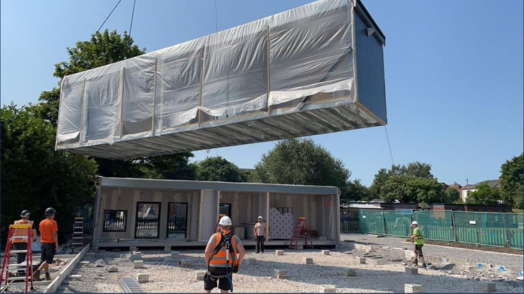Contact our friendly team for more information on our full range of buildings and how to start the process of hiring or buying a modular building for your business. Our expert team is always available to give advice, guidance or support.
Published: 20 August 2021 in Sectors
Can Sensory Rooms In Schools Help Students?

The school environment can feel stressful and overwhelming for pupils with Special Education Needs (SEN). For this reason, sensory rooms can provide a safe and calm space as part of the school environment – and a modular building is the perfect type of space to do just that.
What Is A Sensory Room?
A sensory room is a space dedicated to stimulating, developing and relaxing the senses.
Unlike a regular school classroom, where children usually watch and listen to the teacher, a sensory room allows pupils to explore their learning environment for themselves, using all of their senses. Special education needs come in many forms, but sensory rooms can adapt and cater for a wide range of learning needs and physical requirements.
A few reasons to consider having a sensory room:
- They provide a therapeutic environment for children with SEN
- Sensory equipment can develop certain skills
- The sensory room can act as a calming space for pupils experiencing behavioural problems
- Sensory rooms help children to manage their emotions in a controlled environment, without feeling they are being isolated or punished
- Sensory rooms are perfect for Emotional Literacy Support Assistant (ELSA) sessions
Why Have a Sensory Room at School?
There is a real case for having sensory rooms in schools, as a significant number of children in the UK have special educational needs and would benefit from a learning environment that is suited to their learning style.
Although the SEN Code of Practice stresses the importance of not assuming hard and fast categories of SEN, children with SEN and disabilities have certain learning needs and requirements, as can be seen in the education portion of the GOV.UK website. There are a number of different students at SEN-specific as well as mainstream schools, of all ages, who would benefit from having a designated sensory room. This can include but is not limited to, those with:
- Hypersensitivity issues
- Learning difficulties
- Developmental delays
- Sensory impairments
- Autism
- Behavioural issues
Sensory issues can either involve hypersensitivity (too much stimulus is difficult to cope with) or hyposensitivity (the same level of intensity isn’t experienced in the same way others do). And because everyone has different learning styles, a multi-sensory approach can cater for many different, individual learning styles.
What Can Be Installed In A Sensory Room?
With nearly 12% of the school population on SEN support, every school has a responsibility to support this diverse group of students, providing the facilities they need to get the most out of their education.
For many children, interaction with sensory stimuli can help them to develop their sight, sound, touch, and hearing. Therefore, to provide a stimulating learning environment that allows children to thrive, this type of equipment may be featured:
- Fibre optics and mirrors
- Bean bags, cushions, and mats
- Low lighting and adjustable lighting projections
- Tactile toys and objects to examine
The use of such sensory equipment can help children to develop a range of skills including:
- Hand-eye coordination
- Motor skills
- Colour recognition
- Communication
Modular Sensory Rooms
Our strong relationships with education authorities across the UK have led our research and development team to produce many innovations to help make our buildings highly adaptable. Therefore, we have a variety of innovative features (and always safe) available to you, such as:
- Roller blinds with anti-ligature mechanisms to prevent accidents
- Soft-close doors to stop fingers from getting trapped
- Anti-scald taps to children can wash their hands with warm soapy water, without the worry of them getting hurt
- Lockable, solar tinted windows which protect against harmful UV rays
- Wheelchair and buggy-friendly facilities throughout the building
- Wheelchair-accessible showers and wet rooms
- Accessible ramps
- Door & window finger guards
- Low-level toilets and height-adjustable washbasins so that the bathroom is perfect for all children
- Lighting proved to enhance learning
- Electronically controlled roof skylights with automated ventilation management and rain sensors
- Intervention rooms
- Access control on external doors
- Heavy-duty plasterboard to provide increased impact resistance & soundproofing to a 35db rating
- Spacious designs created to accommodate specialist equipment such as integral oxygen cylinders and leg rests as well as a parked wheelchair
- Weight-bearing ceiling track hoists
It’s common for us to hear that most schools are short on space, but we know that a modular building can create the perfect environment that meets your pupils’ requirements, no matter what.
For further information on projects we have previously successfully delivered, take a look at our case studies, testimonials and brochure.
Or, to get in contact with our expert team for a friendly discussion, give us a call on 01744 851 958, fill out our contact form or request a callback, we would love to work with you to create your school’s ideal learning environment.









